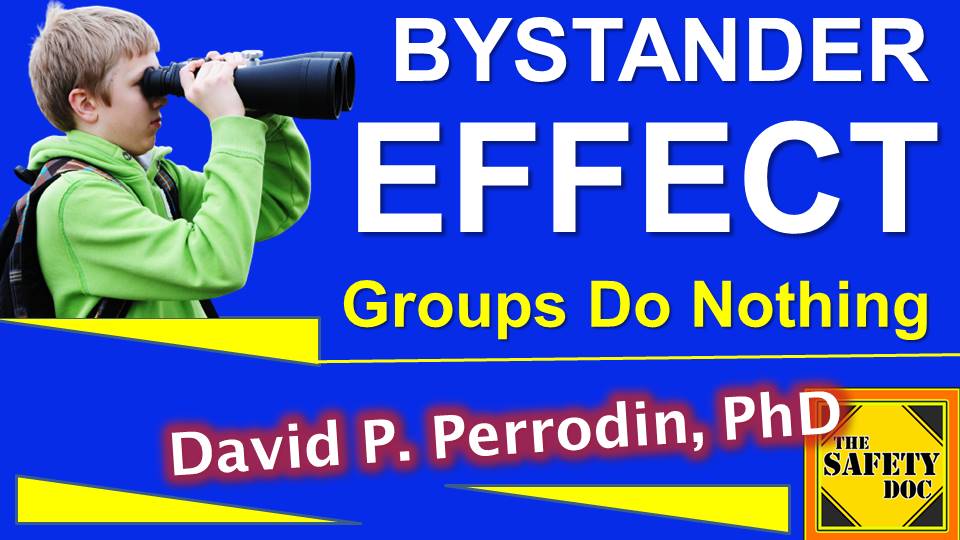Bystander Effect | Why Are We Unwilling To Help When Others Are Watching? | SDP200
It’s counterintuitive, but research findings indicate that someone in need is more likely to receive help when one person is present compared to when several people are standing by. That’s right, you are less inclined to #help another person in trouble if you are in a group. But, wouldn’t the group be more capable and powerful to help than any single individual of the group? Most of us have seen inspiring videos of strangers locking arms to create a human chain in order to rescue a victim struggling in a swollen river. Anecdotally, we might be more willing to collectively intervene to counter a force of nature. That river won’t hire a lawyer and sue us. In this episode, Doc defines the bystander effect, identifies the three types of #bystandereffect, provides reasons for the #bystander effect, and concludes with ways to overcome the bystander effect.

DIRECT LINK to MP3 of this Episode: https://tinyurl.com/SDP200-AUDIO
WHAT IS THE BYSTANDER EFFECT? “Psychologists Bibb Latané and John Darley identified a pattern of behavior they called the bystander effect, which they demonstrated in their labs for the first time in 1968. They describe it as a #behavior that occurs when the presence of others discourages an individual from intervening in an emergency situation. Latané and Darley were spurred to their studies by the 1964 murder of Kitty Genovese in New York City, a case that became infamous because of observers’ inaction (Vernon, J., Overcoming the Bystander Effect. American Scientist). Genovese, age 28, was returning from her job as a manager of a bar when she was brutally attacked and murdered near her residence in Queens, New York. 38 eye witnesses stood by as she was stabbed and killed. None of them called the police.

3 TYPES OF BYSTANDER EFFECT. Researchers Latané and Darley (1970), proposed three different psychological processes that might prevent a bystander from helping a person in distress. (1) diffusion of responsibility; (2) evaluation apprehension (fear of being publicly judged); and (3) pluralistic ignorance (the tendency to rely on the over-reactions of others when defining an ambiguous situation).

REASONS FOR THE BYSTANDER EFFECT. When we are in a group, it’s easier to assume that someone else will step and do something – that there is someone “better-qualified” to lend help. When people make the assumption that someone will spring into action, no one actually steps up and helps. And, oddly, the most common observation at the scene of an accident is a sea of people aiming their phones at the incident. This also amplifies evaluation apprehension as an individual’s attempts to render aid will be forensically analyzed from fifty angles. Undoubtedly, the lack of overt public education about Good Samaritan laws (all at the state level) toss dust into the cost-reward measurement of potential responders. “Does the law have my back if I step up and step in to help?”
PILIAVIN SUBWAY STUDY. In 1969, researchers designed a study to investigate how a group of people would react if they saw a person who collapsed on a train. Here are notable findings from that study: (A) The public usually helped quickly and on their own – nobody had to direct them what to do; and, (B) The longer no help was offered, the more likely it was that observers would leave the incident. Piliavin proposed that humans are hard-wired to become physiologically aroused when they see someone in distress. The longer they think about responding, the less likely they are to respond.
HOW TO OVERCOME THE BYSTANDER EFFECT. Many people experience the cost of “regret” for not helping when they were capable of helping. They might experience guilt, disapproval, damaged self-esteem and negative emotional responses. To overcome the bystander effect, people must practice situational awareness and, in doing so, heighten their ability to recognize when things begin to change from the baseline. This is often the tacit ability of identifying that something is, in fact, an emergency. Feel responsible to take action. That’s a tough call, though, as you can’t place yourself in harm’s way. You might be able to dodge downed live wires to carry someone from a wrecked car – or you might be electrocuted. Finally, choose a form of assistance. You might be able to apply pressure to a cut that’s bleeding. Maybe you can be on the phone with 9-1-1 relaying important information about the event. What if you need help – and what if the crowd watches as you fade away.
SOURCES: Latané, Bibb & Nida, Steve. 1981/03/01. Ten Years of Research on Group Size and Helping. Psychological Bulletin; Piliavin I. M., Rodin, J., & Piliavin, J. A. (1969). Good samaritanism: an underground phenomenon?. Journal of personality and social psychology, 13(4), 289.
This is episode 200 of The Safety Doc Podcast published on 12-27-2022. This podcast and blog post represent the opinions of David P. Perrodin and his guests to the show. The content here is for informational purposes only. Please consult with your safety professional regarding the unique needs of yourself or your organization.
FOLLOW
- Watch this episode on “The Safety Doc” YouTube channel https://tinyurl.com/SDP200-VIDEO
- Listen to this episode on PodBean MP3 https://tinyurl.com/SDP200-AUDIO
- Apple Podcasts http://tinyurl.com/SafetyDocApplePodcasts
- SAFETY DOC WEBSITE & BLOG safetyphd.com
- Follow David & The Safety Doc Podcast on Twitter @SafetyPhD
- Email Dr. Perrodin [email protected]
Purchase Dr. Perrodin’s books
School of Errors – Rethinking School Safety in America
The Velocity of Information – Human Thinking During Chaotic Times
